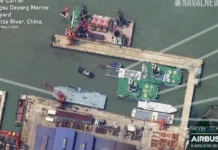
Shipwrecks of the Dover Straits. By Stefan Panis. Whittles Publishing Ltd, Caithness, Scotland, 2024. ISBN 978-184995-496-9
Reviewed by David Hobbs
Stefan Panis is a highly-experienced Belgian technical diver with specialist knowledge of wrecks in the North Sea and Dover Straits. The Dover Straits are the narrowest part of the English Channel and one of busiest international seaways in the world.
Stefan Panis started diving at the age of 6 and qualified professionally in 1992. His expertise extends to diving in both caves and flooded mines and he became a member of the Explorers’ Club in 2020. He is a professional underwater photo-journalist and wreck researcher and, in addition to numerous articles, he has written four books.
The exact number of wrecks off the Kent coast is unknown but there are believed to be at least 100 medieval examples, about 2,000 from the 18th century besides many from the 19th Century and the modern era. Many have become visible as shifting sandbanks reveal previously covered artefacts. Panis describes eighteen wreck sites, each one of them well illustrated with colour photographs showing the wreck itself as well as artefacts in situ and after recovery to the surface. The majority have black and white images of the ships as they appeared before their loss and in some cases specific details such as anchors or machinery. Both the photographs and their reproduction on the printed page are of high quality, allowing the reader to gain a good idea of the state of the wreck and objects that have been brought to the surface. These range from cannons, coins, silverware and crockery to marble fragments with inscriptions. The author explains that some of these were used to identify wrecks and they provide fascinating links to his research work which is illustrated in some cases with reproduced contemporary newspaper articles describing the loss of some ships.
The wrecks date from a number of periods and include several passenger ships, one of which was the Josephine Williswhich was outbound from St Katherine’s Dock, London, to Auckland, New Zealand on 3 February 1856 when she sank with the loss of 70 lives after a collision off Dungeness. There are also details of a hospital ship, troopship and the 1,360 ton ‘B’ class destroyer Brazen which was sunk whilst under tow after being severely damaged by enemy air attack off Dover on 20 July 1940. After 45 minutes she broke in two; the after part sank but the bow slowly rose to the vertical whilst continuing to float. It was eventually sunk by gunfire from her sister-ship Boreas. No-one was killed but six ratings were injured, one of which subsequently died of his wounds in hospital. There are photographs of the ship as well as details such as a depth charge thrower and torpedo tubes to help the reader identify wreckage photographed on the seabed. I am certainly no diving expert but this is one entry in which I spotted a small mistake. On page 35 there are three images captioned as HMS Brazen, two of these show the ship that is the subject of the dive but the third, captioned ‘HMS Brazen on patrol in the English Channel’ shows the earlier 390 ton destroyer of the same name which was launched in 1896 and sold for scrap in 1919. A minor slip amid such a wealth of carefully collated detail.
For anyone with an interest in wreck diving or the study of material found in them which often opens a ‘window’ into the era in which the ship sank, this book offers a fascinating collection of photographs which are put into context by brief details of the ships themselves and the author’s dives with friends. It has to be pointed out that both he and his colleagues respect ships that are war graves and that all the artefacts they recover are reported to the UK Receiver of Wrecks. The book makes a good contribution to an evolving area of maritime history and I recommend it.



